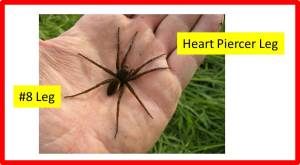Tags
Accidental Boob Grab, Analogue World, Cliff Top Walking, Digital World, Facial Pattern Recognition, Fen Raft Spider, Fuzzy Logic, Grey Zone, Lindy Hop, Money Spider, Strictly Come Dancing
 Today’s topic is the grey zone. “What’s the grey zone?” you ask. Well, it’s the title of a harrowing 2001 film about Auschwitz for one thing but that’s not what I want to talk about. The grey zone is the area between TRUE and FALSE, One and Zero, Right or Wrong, Male and Female, Black or White—that is, the area between two extremes where a judgement is called for. I’ll explore the grey zone through three different scenarios: dance floor etiquette, cliff-top walking, and spiders.
Today’s topic is the grey zone. “What’s the grey zone?” you ask. Well, it’s the title of a harrowing 2001 film about Auschwitz for one thing but that’s not what I want to talk about. The grey zone is the area between TRUE and FALSE, One and Zero, Right or Wrong, Male and Female, Black or White—that is, the area between two extremes where a judgement is called for. I’ll explore the grey zone through three different scenarios: dance floor etiquette, cliff-top walking, and spiders.
Dance floor etiquette—how to behave on the dance floor—is applied to social dancing and especially to formal dance competitions. It’s an unwritten rule, or maybe it’s written down somewhere, that when a man and a woman dance together, the man is forbidden to touch the breasts of his female partner. But, it happens, usually accidentally, and when it does I discovered it’s called an Accidental Boob Grab, ABG. What a great term! (Incidentally, if the woman accidently kicks the man in the groin area, as can easily happen in many vigorous dance styles, is this called an ABK or maybe AKitB?)
In 2009, Chris Hollins and Ola Jordan won the UK Strictly Come Dancing final with an energetic and stylish version of the lindy hop dance. The lindy hop is a cross between Charleston, jazz, tap, jive and breakaway styles of dancing. The dancers are either in tight energetic hold or in what is called swingout where each dancer is either dancing solo (as in the jive) or with minimum contact, usually just hand holding. The transition between hold and swingout is often very spirited and offers many opportunities for an ABG. But, when is an ABG not an ABG? If the man momentarily places his hand below the woman’s breast, or by the side, then no ABG is declared. But if the man partially covers the woman’s breast either as an under boob or side boob touch, is this an ABG? If the man definitely cups the whole of the women’s breast then, yes, this is a clear ABG and a violation of the etiquette rule. We have a grey area of what is an ABG and what is not an ABG.
 A no-hands lindy hop dip: lots of body contact here but no ABG
A no-hands lindy hop dip: lots of body contact here but no ABG
The next example is cliff-top walking. In 2011, when my wife and I walked part of the South West Coastal Path between Newquay on the north Cornish coast to The Lizard on the south coast via Land’s End, we often encountered sections of the trail that were fairly close to an unprotected cliff top (no railing or vegetation). Now, we can argue on what constitutes a cliff top; my wife’s definition is different to mine: 30° off the horizontal (hers) versus my 60°+ drop, but I’m more interested in the safety zone distance between me and the cliff top. If the path is a full body length, say 2 metres, away from the unprotected cliff top, I feel comfortable. If the distance between me and the drop is, say, 1 metre, then my anxiety starts to rise, and if I am placing my boots just 25 cm away from the edge, I am distinctly uncomfortable and may not proceed. (My wife is the same but multiply each of my personal safety-zone distances by four to get her comfort-to-panic range.) So, here is another grey area.
 Close to the edge? Approaching Cudden Point, Prussia Cove, South West Coastal Path, May 2011.
Close to the edge? Approaching Cudden Point, Prussia Cove, South West Coastal Path, May 2011.
Now consider spiders. I don’t like spiders, especially in the house. I don’t kill them but I urge my wife to gather them up in a glass and deposit them outside the house, preferably further away than they can walk in a day. But, I’m okay with money spiders, those tiny friendly eight-legged arachnids who are supposedly the bringers of new clothes and possibly good fortune. If it was a fen raft spider however (see below), I’d run a mile as would my wife incidentally. So, it’s a size thing—body diameter and diametrically opposite leg span. If the body diameter is greater than, say, 0.5 cm, I’m out of there. Similarly if the #8-to-heart-piercer leg span is greater than, say 3 cm, I’m also out of there. Once again, there are two extremes: a money spider is okay whereas a regular household spider (or anything greater) is not, with a grey zone in-between.
 A fen raft spider. This is not my hand!
A fen raft spider. This is not my hand!
Trying to quantify these grey zones fascinates me. In my professional career as an electronics engineer, I worked in the digital domain where everything is clean and Boolean: the TRUE or FALSE, One or Zero world. In other words, binary. I liked the binary world. There were no grey zones, or so I thought until I came across fuzzy logic. This is surely an oxymoron, I mused, like pretty ugly and deafening silence. How can logic be fuzzy? But it can. Fuzzy logic is an n-valued algebra that builds on Boolean concepts and allows degrees of truth whereas classical 2-valued logic (my binary world) only allows TRUE or FALSE outcomes. I won’t go into the mathematical details of fuzzy logic but its applications are all around us—in washing machine controllers, facial pattern recognition systems, vacuum cleaners, drone controllers, anti-skid braking systems—the list is endless. All the practical applications are to systems that have a grey zone. Consider facial recognition systems. If you have a biometric passport, you can use it to gain entry into the UK at airports such as Gatwick. Mapping the characteristics of your face cannot be a precise science however. We are each uniquely defined and expressed by our DNA and there are over seven billion of us on the planet. Even if you spot your doppelgänger, there will be minute differences between the two faces, yours and his (or hers). In other words, a grey zone. Fuzzy logic appears to have enabled a quantification of facial characteristics accurate enough to allow correct passage for most people through the automatic passport control systems now in use. I haven’t encountered rejection at Gatwick Airport, not yet anyway, but the possibility of a false positive or false negative must exist within the grey zone of these systems. Perhaps I’ll grow a beard and moustache and see what happens next time I travel.
We live in an analogue world where everything is defined by a huge amount of constantly changing variables but, increasingly, scientists and engineers are striving to quantify everything in digital terms. Will the presence of the grey zone always be a limiting factor?
 What’s the time? 12:55 precisely or 12:55-ish?
What’s the time? 12:55 precisely or 12:55-ish?
(^_^)


I’ve been cogitating over this one for quite some time and waiting for that ‘Bazinga’ moment. It’s not going to happen so I will accept that I will remain in the grey zone for the foreseeable future!
LikeLike